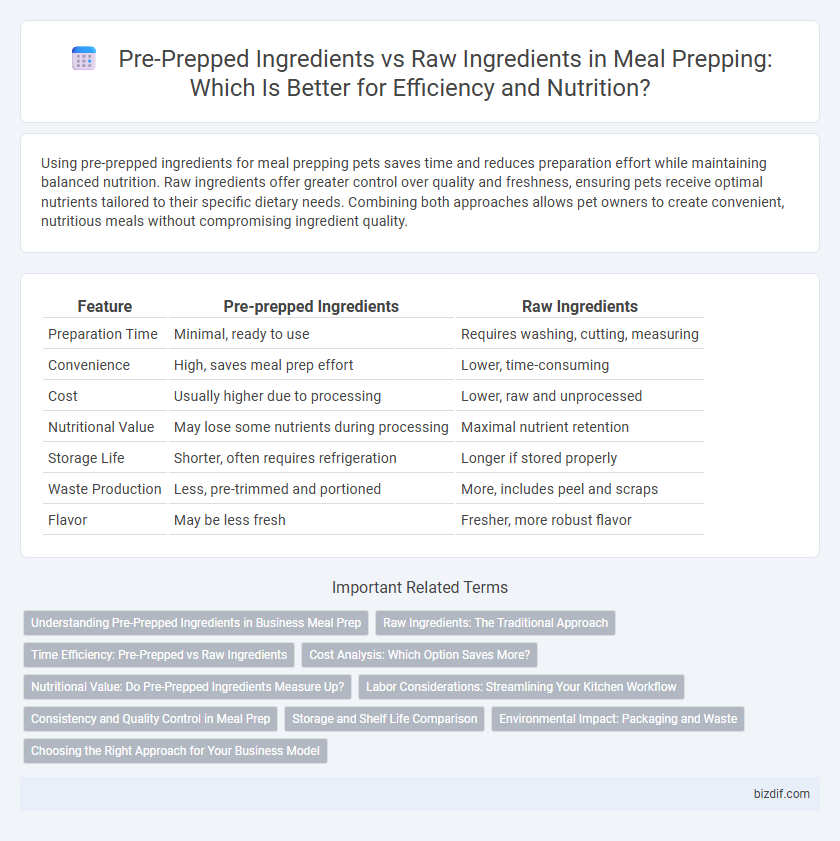Using pre-prepped ingredients for meal prepping pets saves time and reduces preparation effort while maintaining balanced nutrition. Raw ingredients offer greater control over quality and freshness, ensuring pets receive optimal nutrients tailored to their specific dietary needs. Combining both approaches allows pet owners to create convenient, nutritious meals without compromising ingredient quality.
Table of Comparison
| Feature | Pre-prepped Ingredients | Raw Ingredients |
|---|---|---|
| Preparation Time | Minimal, ready to use | Requires washing, cutting, measuring |
| Convenience | High, saves meal prep effort | Lower, time-consuming |
| Cost | Usually higher due to processing | Lower, raw and unprocessed |
| Nutritional Value | May lose some nutrients during processing | Maximal nutrient retention |
| Storage Life | Shorter, often requires refrigeration | Longer if stored properly |
| Waste Production | Less, pre-trimmed and portioned | More, includes peel and scraps |
| Flavor | May be less fresh | Fresher, more robust flavor |
Understanding Pre-Prepped Ingredients in Business Meal Prep
Pre-prepped ingredients, such as chopped vegetables and marinated proteins, significantly reduce labor time and streamline workflows in business meal prep operations. Utilizing these ingredients enhances consistency and food safety while enabling faster meal assembly during peak hours. Incorporating pre-prepped items also minimizes waste and improves inventory management, optimizing overall operational efficiency.
Raw Ingredients: The Traditional Approach
Raw ingredients offer maximum control over freshness, nutrient retention, and flavor customization in meal prepping. Utilizing whole vegetables, unprocessed grains, and fresh proteins enables precise portioning and ingredient quality assessment, essential for dietary goals and taste preferences. This traditional approach supports flexibility in meal variety while ensuring minimal additives and preservatives are present.
Time Efficiency: Pre-Prepped vs Raw Ingredients
Pre-prepped ingredients significantly reduce meal prep time by eliminating washing, peeling, and chopping steps required with raw ingredients. Using pre-prepped components allows faster assembly of meals, ideal for busy schedules seeking time efficiency. Raw ingredients offer fresher flavor and more control but demand considerably more prep time, making them less suitable for quick meal prepping.
Cost Analysis: Which Option Saves More?
Pre-prepped ingredients typically cost more upfront due to added labor and convenience fees, yet they reduce food waste and save time during meal prep. Raw ingredients generally offer lower prices per unit, enabling bulk purchasing and long-term savings, but may involve higher prep time and potential spoilage. Analyzing weekly meal plans and personal time value helps determine whether pre-prepped or raw ingredients provide greater overall cost efficiency.
Nutritional Value: Do Pre-Prepped Ingredients Measure Up?
Pre-prepped ingredients often experience nutrient loss due to exposure to air, heat, and prolonged storage, diminishing levels of vitamin C and antioxidants compared to raw ingredients. However, they offer convenience without significantly compromising macronutrients like protein, carbohydrates, and fats essential for balanced meal prepping. Choosing fresh, minimally processed pre-prepped options can help maintain higher nutritional value while saving meal preparation time.
Labor Considerations: Streamlining Your Kitchen Workflow
Using pre-prepped ingredients significantly reduces labor time by eliminating tasks such as washing, chopping, and peeling, enabling a faster, more efficient kitchen workflow. Raw ingredients demand more hands-on preparation but offer greater control over freshness and portion sizes, which might be essential for specific dietary needs. Balancing pre-prepped and raw components optimizes productivity without compromising quality in meal prepping routines.
Consistency and Quality Control in Meal Prep
Pre-prepped ingredients offer consistent portion sizes and uniform quality, reducing variability in meal preparation and ensuring reliable nutritional content. Raw ingredients may vary in freshness and size, making quality control more challenging and potentially affecting the taste and appearance of meals. Utilizing pre-prepped components streamlines the process while maintaining high standards for consistency and quality in meal prep routines.
Storage and Shelf Life Comparison
Pre-prepped ingredients typically have a shorter shelf life compared to raw ingredients due to partial processing and increased exposure to air and moisture, which accelerates spoilage. Raw ingredients, when stored properly in airtight containers and at optimal temperatures, can last longer and retain nutritional value better. Choosing raw ingredients can reduce waste and improve freshness, while pre-prepped options offer convenience at the expense of reduced storage time.
Environmental Impact: Packaging and Waste
Pre-prepped ingredients often generate more packaging waste due to individual containers, increasing the environmental footprint compared to raw ingredients that require minimal packaging. Raw ingredients typically produce less plastic waste and allow for composting of organic scraps, reducing landfill contributions. Choosing raw ingredients supports sustainable consumption by minimizing packaging waste and promoting eco-friendly meal preparation.
Choosing the Right Approach for Your Business Model
Selecting pre-prepped ingredients streamlines kitchen operations, reduces labor costs, and ensures consistency, making it ideal for high-volume meal prep services targeting fast turnaround. Raw ingredients offer greater flexibility for customization, fresher taste profiles, and potentially lower ingredient costs, aligning well with businesses emphasizing bespoke meals or premium quality. Analyzing order volume, staffing capabilities, and target customer expectations is crucial to determine the optimal approach for sustainable growth.
Pre-prepped ingredients vs raw ingredients Infographic

 bizdif.com
bizdif.com